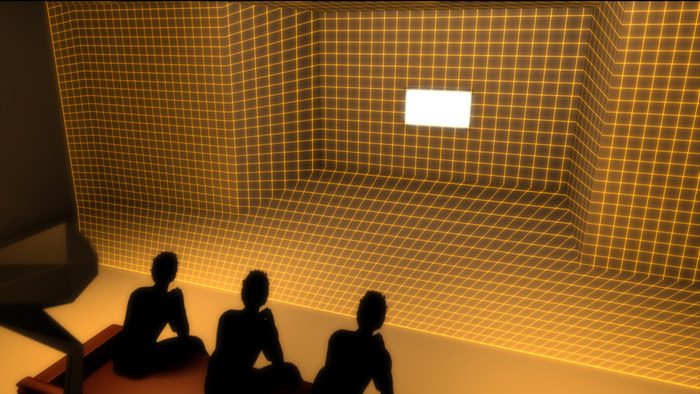It’s time we rethink virtual and augmented reality. Since VR devices became occasional news fodder, they’ve seen only incremental changes to design and function. Expect a gaudy headset. Expect some sort of hybrid controller. Anticipate a headache.
Catopsys took a different approach with Immersis, a virtual/augmented reality device that takes a step back from wearables and delivers a fresh way to experience VR/AR.
Rather than bringing the virtual image directly to your eye, Immersis casts a 180º projection onto your environment. Like the virtual reality cave used by AEROCAMPUS Aquitaine, Immersis turns a bare room into an interactive virtual world. Think of the planetarium without fifty snotty school kids.

Immersis bills itself as, “The ultimate virtual reality experience for immersive gaming and video, sharable with others and adaptable to your living space.” By dissolving the VR headset — which isolates wearers from others — Immersis hopes to make the VR experience social, inclusive, and non-nauseating.
Stereoscopic technology used in VR headsets requires the wearer to adjust her visual perception, as the virtual image is brought sometimes within centimeters of her face. This often results in a kind of motion sickness so significant that’s it has its own names: simulator sickness, VR sickness, and stillness illness. Oculus experienced these obstacles early on and even set out parameters by which software developers could help mitigate the condition.
Rather than compromise on stillness illness, Catopsys evaded the obstacle entirely. By projecting the virtual image onto the walls, users don’t need to adjust their depth perception to avoid that cross-eyed headache you get from viewing things too close.
Despite the company’s claim to challenge VR paradigms, the Immersis experience is closer to augmented reality than virtual reality. Similar to how Microsoft’s recently announced HoloLens incorporates virtual reality with reality, Immersis projects images onto your already present reality. The environment this projection creates includes — and even depends on — the wearers surroundings. Standard VR headsets on the other hand try to eliminate the presence of a world outside the headset in order to fully immerse wearers into the virtual world they’re witnessing.

The inclusive, social aspect of Immersis is a welcome alternative to isolating VR experiences. Even the HoloLens experience is essentially locked within one’s own perception. Immersis instead invites others to participate in viewing an augmented world together. There’s something strange about watching a film with friends while each person wears a VR headset of their own. The virtual world of each headset may be the same, but the wearers are in an independent and isolated experience. Immersis brings immediate human relations back to this experience. You can meet the eyes of the person sitting next to you to share the feelings, thoughts and emotions that accompany most media. Whether experiencing a broadcasted football final or the trials of a Syrian refugee, Immersis lets people do it together.
Catopsys makes it clear that their technology is different from — while sort of implying it may be derivative of — another of Microsoft’s projects: Illumiroom. Developed in 2012, Illumiroom would divide a mother image into multiple peripheral images, and then project these peripheral images with overlap to create depth. The result would be a broken but comprehensive and responsive image. Illumiroom deforms the image whereas Immersis distorts it. Immersis stretches and condenses a mother image rather than dividing it, and the company claims the result is something more fluid, realistic, and…immersive.
Immersis has exceeded its $100,000 KickStarter funding goal with three weeks left in the campaign. One hundred fifty-nine eager backers have pledged anywhere from $5 for a “heartfelt Thank You,” to $3,000 for a custom device “signed by the entire team.” If you’re an early adopter with some extra cash and an interest in a unique take on VR/AR, pledge here for one of the first round Immersis devices.
Image credits: Catopsys, Kickstarter


















